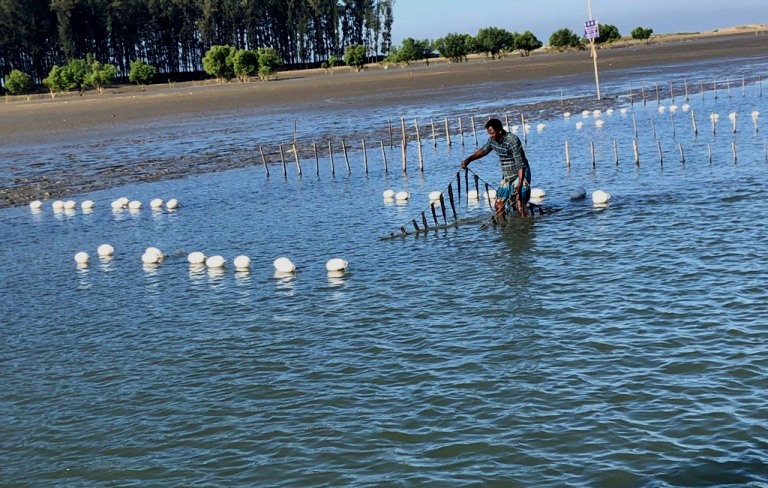
Immense potential of seaweed
Bangladesh News Desk
Published:18 Dec 2021, 11:36 AM

Immense potential of seaweed
The coastal population in Bangladesh are gradually taking up cultivation of seaweed as a new source of livelihood due to its rising demand in the local and international market.
During a visit to Cox's Bazar, it was seen that a couple of women were cultivating seaweed at Rejukhal, a tidal canal with saline water into Bay of Bengal. They set a long queue of bamboo poles along the waterway, which is an artificial method of growing seaweed, reports DT.
In addition to men, a significant number of women in Cox’s Bazar are also getting involved in seaweed processing and marketing as a new source of livelihood.
Women are very much used to processing seaweed abundant in Nuniarchar, Hajipara, Rejukhal area of Cox’s Bazar sadarupazila.
They are also involved in marketing of the seaweed. The raw seaweeds are usually sold at Tk60 per kg and the dry ones at Tk200 to Tk250.
The ethnic minorities in different upazilas of Cox’s Bazar and Chittagong Hill Tract are the main consumers of seaweed in the country right now.
Potential in Bangladesh
Due to easy access to labour and a huge coastal zone with 480km of coastline and 25,000 sq-km of coastal area, Bangladesh can be one of the biggest seaweed producers in the world in the future, according to scientists, experts and local farmers.
The Food and Agriculture Organization of the United Nations (FAO) says seaweed farming is one of the fast-growing aquaculture sectors globally with an annual production of about 33 billion tons, valued at $11.8 billion. This is anticipated to double within two years.
“Bangladesh currently produces some 400 tons of seaweed, valued at Tk55 million,” said Mohammad Shah Nawaz Chowdhury, associate professor, Institute of Marine Sciences and Fisheries, University of Chittagong.
“Production can be easily increased more if the government and private organizations come forward,” he said.
According to a study titled “seaweed for blue economy in Bangladesh”, seaweed production in Bangladesh could be increased to 50 million tons from shallow coastal waters by 2050.
However, people across the country hardly know about seaweed. There are also many misconceptions and social stigma among the coastal communities.
What the experts say
Researchers have been promoting seaweeds with scientific data to remove the negatives around this sector with huge potentials.
According to the experts, seaweed is healthy for human bodies, skin, the environment, and the economy, and there is much potential in Bangladesh to develop commercial cultivation.
“Seaweed grows in saline water and can be easily cultivated. As a result, there is ample opportunity for seaweed to be used locally as well as for export,” said Md Shah Nawaz Chowdhury, associate professor, Institute of Marine Sciences and Fisheries, University of Chittagong.
“Seaweeds are being used in the production of a wide range of items, including food, medicine, cosmetics, fertilizers, biofuels and products to prevent environmental pollution, '' he said.
“There is huge potential for seaweed production in Bangladesh to support nutrition security, livelihoods, as well as exports to meet global demand,” said MdRuhul Amin Talukder, additional secretary of the Ministry of Agriculture.
Attending a workshop in Cox’s Bazar, he said: “Seaweed is highly nutritious. We need to create awareness among the general public to include it as a daily food item.
Robert D Simpson, FAO representative in Bangladesh, said: “Seaweed is a great resource of the sea. It can be eaten and processed as an ingredient for a wide range of items, including medicine, cosmetics, fertilizers, biofuels and products to prevent environmental pollution."
He said: “This project has demonstrated the viability and potential of commercial seaweed cultivation, processing, and marketing in Bangladesh.
“We will work with the government and other partners to exploit the potential."
A rising trend in Cox’s Bazar
Farmers say it takes only a month to harvest seaweed. However, cultivation is suspended during the rainy season due to high tide.
“We invest Tk20,000-30,000 in a season to cultivate seaweed and get a return of Tk80,000-90,000. It provides a great support for our family,” said Nasima Akhter, a seaweed farmer in Nuniarchara area of Cox’s Bazar.
“My husband and elder son also help me with the processing and selling of the seaweed as they are unable to deposit such an amount working as a day labourer,” she added.
NurNahar, a seaweed farmer in Hajirpara area of Cox’s Bazar Sadar, said: “By investing Tk80,000-90,000 in cultivating seaweed, we can earn more than Tk1.5 lakh.”
Like them, many local farmers are getting interested in cultivating seaweed.
“Cultivation of seaweed is being expanded as it gradually becomes popular among the local community and tourists, '' said DrKabir Uddin Ahmed, a scientist at Bangladesh Agriculture Research Council (BARC).
Government and non-government interventions
Experimental cultivation of two species of seaweed first began at Saint Martin’s Island in 2010.
Since 2016, Bangladesh Agricultural Research Institute (BARI) has been cultivating seaweed in the coastal areas of Cox's Bazar.
The FAO and the Ministry of Agriculture recently completed a joint pilot project that aimed to kick-start the country’s seaweed industry.
As a part of its efforts to popularize edible seaweed as well as its use in cosmetics, the FAO recently organized a fair to showcase seaweed products made by local farmers and entrepreneurs. It also distributed 25 carts of seaweed to food entrepreneurs in Cox's Bazar.
According to FAO, the project trained 120 farmers in seaweed culture and processing, 40 participants in seaweed-based food production, and 20 participants in creating seaweed-based herbal cosmetics. More than half were women.
“The farmers, who got the training, have gained the ability to expand the cultivation of seaweed in Bangladesh,” said Nur Ahmed Khondaker, assistant FAO representative in Bangladesh.
"A new development project proposal is being prepared for expanding cultivation of seaweed,” said DrKabir Uddin Ahmed, a scientist at BARC.
Seaweed production in Bangladesh can increase to 50 million tons by 2050, says a study